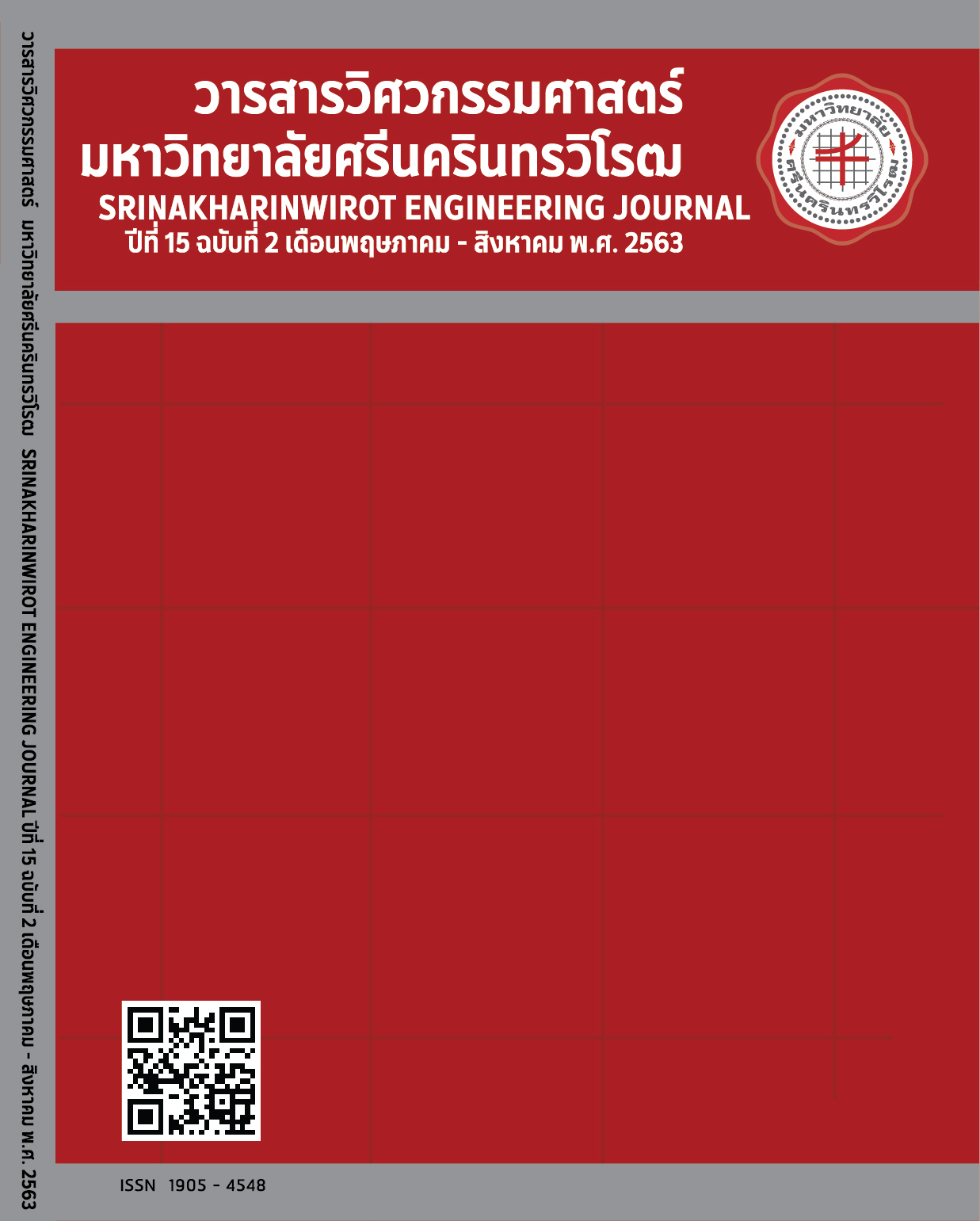การใช้ประโยชน์จากกากแคลเซียมคาร์ไบด์และเถ้าก้นเตาเป็นวัสดุประสานสำหรับคอนกรีตบล็อก
Main Article Content
บทคัดย่อ
งานวิจัยนี้จึงมีวัตถุประสงค์เพื่อนำกากแคลเซียมคาร์ไบด์และเถ้าก้นเตาเป็นวัสดุประสานสำหรับการผลิตคอนกรีตบล็อกทดแทนการใช้ปูนซีเมนต์ปอร์ตแลนด์ การศึกษาครั้งนี้ได้นำกากแคลเซียมคาร์ไบด์และเถ้าก้นเตามาบดละเอียด และผสมในอัตราส่วนระหว่างกากแคลเซียมคาร์ไบด์ต่อเถ้าก้นเตาเท่ากับ 30:70 (CB) เพื่อใช้เป็นวัสดุประสานในการผลิตคอนกรีตบล็อกรับน้ำหนักเชิงตัน คอนกรีตบล็อกที่ใช้ในการศึกษาครั้งนี้มีขนาดตัวอย่างเท่ากับ 100x100x200 มม.3 ทำการศึกษาความหนาแน่น ค่าดูดกลืนน้ำ และกำลังอัดของคอนกรีตบล็อก CB เพื่อเปรียบเทียบกับผลการทดสอบคอนกรีตบล็อกที่ใช้ปูนซีเมนต์ปอร์ตแลนด์ (CT) ผลการทดสอบพบว่าค่าดูดกลืนน้ำ และกำลังอัดขึ้นอยู่กับความหนาแน่นของคอนกรีตบล็อก กล่าวคือความหนาแน่นของคอนกรีตบล็อกมีค่ามากส่งผลให้ค่าการดูดกลืนน้ำลดลงและกำลังอัดของคอนกรีตบล็อกมีค่าเพิ่มขึ้น การใช้วัสดุประสาน CB สำหรับหล่อเป็นคอนกรีตบล็อกมีผลให้ค่าการดูดกลืนน้ำสูงขึ้นและกำลังอัดมีค่าลดลง อย่างไรก็ตาม ค่าการดูดกลืนน้ำและกำลังอัดของคอนกรีตบล็อก CB สามารถปรับปรุงได้โดยการเพิ่มปูนซีเมนต์ปอร์ตแลนด์ในส่วนผสมร้อยละ 10 โดยน้ำหนัก การใช้แรงดัน 6 กก./ตร.ซม. ในการขึ้นรูป และการลดอัตราส่วนน้ำต่อวัสดุประสานในส่วนผสม ด้วยเหตุนี้จึงทำให้ค่าการดูดกลืนน้ำและกำลังอัดของคอนกรีตบล็อกที่ผ่านการปรับปรุงสามารถผ่านเกณฑ์มาตรฐานของคอนกรีตบล็อกรับน้ำหนักเชิงตัน สำหรับการใช้งานเป็นกำแพงเหนือและต่ำกว่าระดับพื้นดินโดยปราศจากการป้องกันผิวได้ตามาตรฐาน มอก. 60-2561 กำหนด
Article Details
ลิขสิทธิ์เป็นของวารสารวิศวกรรมศาสตร์ มหาวิทยาลัยศรีนครินทรวิโรฒ
เอกสารอ้างอิง
G. Habert, C. Billard, P. Rossi, C. Chen and N. Roussel, “Cement production technology improvement compared to factor 4 objectives,” Cem. Conc. Res., vol. 40, no. 5, pp. 820–826, 2010.
E. Gartner, “Industrially interesting approa-ches to “low-CO2” cements,” Cem. Conc. Res., vol. 34, no. 9, pp. 1489–1498, 2004.
C. Jaturapitakkul and B. Roongreung, “Cementing material from calcium carbide resi-due-rice husk ash,” J. Mat. Civ. Eng, ASCE, vol. 15, no. 5, pp. 470–475, 2003.
C. D. Altis, “High-volume fly ash concrete with high strength and low drying shrinkage,” J. Mat. Civ. Eng, ASCE, vol. 15, no. 2, pp. 153–156, 2003.
A. Rerkpiboon, W. Tangchirapat and C. Jaturapitakkul, “Strength, chloride resistance, and expansion of concretes containing ground bagasse ash,” Constr. Build. Mat., vol. 101, part. 1, pp. 983–989, 2015.
ปิติศานต์ กร้ำมาตร, สุภิชาติ มาตย์ภูธร, ชัย จาตุรพิทักษ์กุล และ วิมล เงาพิสดาร. “การศึกษากำลังอัดของมอร์ตาร์ที่ได้จากกากแคลเซียมคาร์ไบด์ผสมกับเถ้าถ่านหิน,” วิศวกรรมสารฉบับวิจัยและพัฒนา, ปีที่ 7 (ฉบับที่ 2): หน้าที่ 65–75, 2539.
ธนพล เหล่าสมาธิกุล และ ชัย จาตุรพิทักษ์กุล. “สมบัติเชิงกลของคอนกรีตที่ใช้ส่วนผสมของกากแคลเซียมคาร์ไบด์และเถ้าถ่านหินเป็นวัสดุประสาน,” การประชุมวิชาการคอนกรีตประจำปีครั้งที่ 4. 20-22/10/2551. อุบลราชธานี, 2551, หน้าที่ MAT88–MAT95.
สุทธินันท์ แอเดียว, วีรชาติ ตั้งจิรภัทร และ ชัย จาตุรพิทักษ์กุล. “กำลังอัดและการซึมของน้ำผ่านคอนกรีตที่ใช้กากแคลเซียมคาร์ไบด์ร่วมกับเถ้าถ่านหินเป็นวัสดุประสาน,” วิศวกรรมสารฉบับวิจัยและพัฒนา, ปีที่ 22 (ฉบับที่ 4): หน้าที่ 34–42, 2554.
C. Jaturapitakkul and R. Cheererot, “Deve-lopment of bottom ash as pozzolanic mat-erial,” J. Mat. Civ. Eng, ASCE, vol. 15, no. 1, pp. 48–53, 2003.
H. Kurama and M. Kaya, “Usage of coal combustion bottom ash in concrete mix-ture,” Constr. Build. Mat., vol. 22, no. 9, pp. 1922–1928, 2008.
A. Abdulmatin, W. Tangchirapat and C. Jaturapitakkulya, “An investigation of bot-tom ash as a pozzolanic material,” Constr. Build. Mat., vol. 186, pp. 155–162, 2018.
เพ็ญพิชชา คงเพิ่มโกศล, อรรคเดช อับดุลมาติน, วีรชาติ ตั้งจิรภัทร และ ชัย จาตุรพิทักษ์กุล. “การพัฒนากำลังอัดของคอนกรีตโดยใช้วัสดุประสานจากเถ้าก้นเตาและกากแคลเซียมคาร์ไบด์,” วารสาร วิชาการสมาคมคอนกรีตแห่งประเทศไทย, ปีที่ 4 (ฉบับที่ 1), หน้าที่ 11–19, 2559.
P. Chindaprasirt, C. Jaturapitakkul, W. Chalee and U. Rattanasak, “Comparative study on the characteristics of fly ash and bottom ash geopolymers,” Waste Manage., vol. 29, no. 2, pp. 539–543, 2009.
Standard Specification for Coal Fly Ash and Raw or Calcined Natural Pozzolan for Use in Concrete, ASTM Standard C618, 2015.
A. Abdulmatin, P. Khongpermgoson, W. Tangchirapat and C. Jaturapitakkulya, “Use of eco-friendly cementing material in concrete made from bottom ash and calcium carbide residue,” Arab. J. Sci. Eng., vol. 43, no. 4, pp. 1617–1626, 2018.
อรรคเดช อับดุลมาติน, วีรชาติ ตั้งจิรภัทร และ ชัย จาตุรพิทักษ์กุล. “ผลกระทบของชนิดของสารลดน้ำพิเศษต่อสมบัติของเพสต์และมอร์ตาร์ที่ใช้เถ้าก้นเตาร่วมกับกากแคลเซียมคาร์ไบด์เป็นวัสดุประสาน,” วารสารวิชาการสมาคมคอนกรีตแห่งประเทศไทย, ปีที่ 3 (ฉบับที่ 1), หน้าที่ 31–41, 2558.
ASTM C140 / C140M-18a, Standard Test Methods for Sampling and Testing Concrete Masonry Units and Related Units, ASTM International, West Conshohocken, PA, 2018.
C. Namarak, C. Bumrungsri, W. Tangchirapat, and C. Jaturapitakkul, "Development of Concrete Paving Blocks Prepared from Waste Materials without Portland Cement," Mater. Sci., Vol. 24, no. 1, pp. 92-99, 2018.
V. Živica, "Effects of the very low water/cement ratio," Constr.Build. Mat. Vol 23, no. 12, pp. 3579-3582, 2009
C. Rattanashotinunt, P. Thairit, W. Tangchirapat, and C. Jaturapitakkul, “Use of calcium carbide residue and bagasse ash mixtures as a new cementitious material in concrete,” Mater. Des., Vol. 46, pp. 106–111, 2013.
มาตรฐานผลิตภัณฑ์อุตสาหกรรมคอนกรีตบล็อกเชิงตันรับน้ำหนัก, สำนักงานมาตรฐานผลิตภัณฑ์ อุตสาหกรรม กระทรวงอุตสาหกรรม มอก. 60-2516, 2516.
L. Lam, Y. Wong, and C. Poon, “Degree of hydration and gel/space ratio of high-volume fly ash/cement systems,” Cem. Concr. Res. Vol. 30, no. 5, pp. 747–756, 2000.
R. Duval, and E. Kadri, “Influence of silica fume on the workability and the compressive strength of high-performance concretes,” Cem. Concr. Res. Vol. 28, no. 4, pp. 533–547, 1998.


